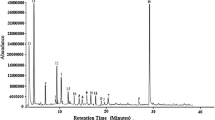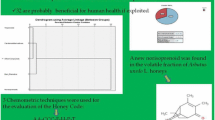Abstract
The volatile organic compounds (VOCs) of twenty multifloral honeys of Prayagraj district Uttar Pradesh produced by Apis dorsata were analyzed by gas chromatography and mass spectrometry (GCMS) detector. A total of major 40 VOCs was identified and classified as alcohol, aldehydes, aliphatic as well as aromatic hydrocarbons, aliphatic acids, esters, fatty acids, furans, ketones, pyrans and their derivatives. The high peak areas in chromatograms for hexadecanoic acid (palmitic acid), 9-octadecanoic acids and 9,12,octadecanoic acids (linoleic acids) indicates their high contents in rural honeys as compared to that of urban honeys. 2(3 H)-naphthalenone,4,4a,5,6,7,8-hexahydro-4a-methyl and heptafluorobutyric acid were found in honeys collected from urban area only. These VOCs found in honeys from urban area can be considered as an indicator to environmental pollution. The present study reports maximum VOCs from honeys collected from rural area and also correlated with the botanical vegetation near the beehives.






Similar content being viewed by others
References
Albero B, Sa´nchez-Brunete C, Tadeo JL (2003) Determination of polycyclic aromatic hydrocarbons in honey by matrix solid phase dispersion and gas chromatography/mass spectrometry. J AOAC Int 86:576–582
Alissandrakis E, Tarantilis PA, Harizanis PC, Polissiou M (2005) Evaluation of four isolation techniques for honey aroma compounds. J Sci food agri 85(1):91–97
Anand S, Pang E, Livanos G, Mantri N (2018) Characterization of physicochemical properties and antioxidant capacities of bioactive honey produced from Australian grown Agastache rugosa and its correlation with color and polyphenol content. Molecules 23:108: 1–12
Barra MPG, Ponce-Díaz MC, Venegas-Gallegos C (2010) Volatile compounds in honey produced in the central valley of Nuble Province, Chile. Chil J Agri Res 70:75–84
Bentivenga G, D’Auria M, Fedeli P, Mauriello G, Racioppi R (2004) SPME-GCMS analysis of volatile organic compounds in honey from Basilicata: evidence for the presence of pollutants from anthropogenic activities. Int J Food Sci Tech 39(10):1079–1086
Beyoglu D, Omurtag GZ (2007) Occurrence of naphthalene in honey consumed in Turkey as determined by high-pressure liquid chromatography. J Food Prot 70(7):1735–1738
Bogdanov S, Ruoff K, Oddo LP (2004) Physicochemical methods for the characterization of unifloral honeys: a review. Apidologie 35:S4–S17
Castro-Vázquez L, Díaz-Maroto MC, Pérez-Coello MS (2006) Volatile composition and contribution to the aroma of Spanish honeydew honeys: identification of a new chemical marker. J Agri Food Chem 54(13):4809–4813
Castro-Vázquez L, Diaz-Maroto MC, Gonzalez-Vinas MA, Pérez-Coello MS (2009) Differentiation of monofloral citrus, rosemary, eucalyptus, lavender, thyme and heather honeys based on volatile composition and sensory descriptive analysis. Food Chem 112:1022–1030
Chowdhury MTJ, Razzaque MA, Sultana N, Mustafiz SSB, Akter S, Akter A, Islam MR (2013) Chlorinated pesticide residue status in some winter vegetables. Int J Agri Crop Sci 6(11):667–675
Christy EML, Roland NN, Clarke AM (2011) Volatile compounds in honey: a review on their involvement in aroma, botanical origin determination and potential biomedical activities. Int J Mol Sci 12:9514–9532
Cuevas-Glory LF, Pino JA, Santiago LS, Sauri-Duch E (2007) A review of volatile analytical methods for determining the botanical origin of honey. Food Chem 103(3):1032–1043
D’Arcy BR, Rentoul GB, Rowland CY, Blackman AJ (1997) Composition of Australian honey extractives.1. Norisoprenoids, monoterpenes, and other natural volatiles from blue gum (Eucalyptus leucoxylon) and yellow Box (Eucalyptus meliiodora) honeys. J Agri Food Chem 45:1834–1843
Da Silva PM, Gauche C, Gonzaga LV, Costa ACO, Fett R (2016) Honey: chemical composition, stability and authenticity. Food Chem 196:309–323
Dekebo A, Kwon SY, Kim DH, Chuleui J (2018) Volatiles analysis of honey by gas chromatography mass spectrometry (GCMS): comparison of SPME volatiles extraction methods. J Apicul 33(2):117–128
Derewiaka D, Majewska E, Kuzak K, Szadkowska D (2021) Comparison of volatiles and chemical composition of traditional and non-traditional honey available on the Polish market. Appl Sci 11:6371–6385
Kaškonienė V, Venskutonis PR, Čeksterytė V (2010) Carbohydrate composition and electrical conductivity of different origin honeys from Lithuania. LWT–Food Sci Tech 43(5):801–807
Khalil MI, Sulaiman SA, Gan SH (2010) High 5-hydroxymethylfurfural concentrations are found in Malaysian honey samples stored for more than one year. Food Chem Toxico 48(8–9):2388–2392
Khan IU, Dubey W, Gupta V (2017a) Characterization of volatile compounds in floral honey from coriander using gas chromatography mass spectroscopy. Int J Seed Spices 7(1):40–43
Khan IU, Dubey W, Gupta V (2017b) Characterization of volatile biochemical compounds in mustard floral honey from Apis melifera by gas chromatography mass spectroscopy. Int J Pharma Bio Sci 8(2):1004–1009
McLafferty FW, Stauffer DB (1989) The Wiley/NBS registry of mass spectral data. 1.Wiley
Nayik GA, Nanda V (2015) Characterization of the volatile profile of unifloral honey from Kashmir Valley of India by using solid-phase microextraction and gas chromatography mass spectrometry. Eur Food Res Tech 240:1091–1100
Panseri S, Manzo A, Chiesa LM, Giorgi A (2013) Melissopalynological and volatile compounds analysis of buckwheat honey from different geographical origins and their role in botanical determination. J Chem 1:1–11
Radovic BS, Careri M, Mangia A, Musci M, Gerboles M, Anklam E (2001) Contribution of dynamic headspace GCMS analysis of aroma compounds to authenticity testing of honey. Food Chem 72:511–520
Salman MA, Alfekaiki DF, Alhilfi AZA (2021) Effect of seasonal on strength of bee and volatile compounds in multiflora honey. Ann Rom Soc Cell Bio 25(6):10533–10541
Sharma S, Kumar S, Kaur G, Banga SS (2022) Floral volatiles may influence honey bee visitations in oil seed Brassica species. J Crop Impro. https://doi.org/10.1080/15427528.2022.2059604
Shen Q, Cheng H, Pu Y, Ren S, Hu L, Chen J, Ye X, Liu D (2018) Characterization of volatile compounds in pickled and dried mustard (Brassica juncea, Coss.) Using optimal HSSPME-GCMS. CyTA–J Food 16(1):331–339
Shukla V, Kumar A (2020) Melissopalynological and physicochemical analysis of honey samples from Prayagraj district Uttar Pradesh. Acta Palaeobotanica 60(1):123–133
Shukla V, Rao KS (2021) Pollen analysis of summer honeys from Prayagraj district, Uttar Pradesh, India. Acta Palaeobotanica 61(1):20–31
Shukla V, Rao KS (2022) Melissopalynological studies of honey from Indo-Gangetic Plain, India. Int J Eco Env Sci 48(1):21–37
Shukla V, Rao KS, Tripathi D (2022) Pollen diversity of honey from northern and southern Prayagraj district Uttar Pradesh, India. Grana 61(2):148–160
Srinivasan A, Maruthavanam T, Mayildurai R, Ramasubbu A (2021) GCMS investigations of VOCs in south Indian honey samples as environmental biomarkers. Env Moni Assess 193:539–550
Tananaki C, Zotou A, Thrasyvoulou A (2005) Determination of 1,2-dibromoethane,1,4-dichlorobenzene and naphthalene residues in honey by gas chromatography mass spectrometry using purge and trap thermal desorption extraction. J Chrom A 1083:146–152
Tosi E, Ciappini M, Re E, Lucero H (2002) Honey thermal treatment effects on hydroxymethylfurfural (HMF) content. Food Chem 77:71–74
Acknowledgements
Sincere thanks to the University Grant Commission, New Delhi, India, for providing financial support to the first author under the woman candidate, Postdoctoral Fellowship. The first author is also grateful to the Head of the Botany Department, University of Delhi, for providing the necessary facilities for this work. Author is also thankful to Prof. Dinesh Mohan, Environmental school of Sciences, Jawaharlal Nehru University, New Delhi.
Author information
Authors and Affiliations
Corresponding author
Ethics declarations
Conflict of interest
No potential conflict of interest was reported by the authors.
Additional information
Publisher’s Note
Springer Nature remains neutral with regard to jurisdictional claims in published maps and institutional affiliations.
Rights and permissions
Springer Nature or its licensor (e.g. a society or other partner) holds exclusive rights to this article under a publishing agreement with the author(s) or other rightsholder(s); author self-archiving of the accepted manuscript version of this article is solely governed by the terms of such publishing agreement and applicable law.
About this article
Cite this article
Shukla, V., Rao, K.S. & Chaudhary, H. Volatile organic compounds of honeys produced by Apis dorsata fabricius. Vegetos (2024). https://doi.org/10.1007/s42535-024-00867-7
Received:
Revised:
Accepted:
Published:
DOI: https://doi.org/10.1007/s42535-024-00867-7




